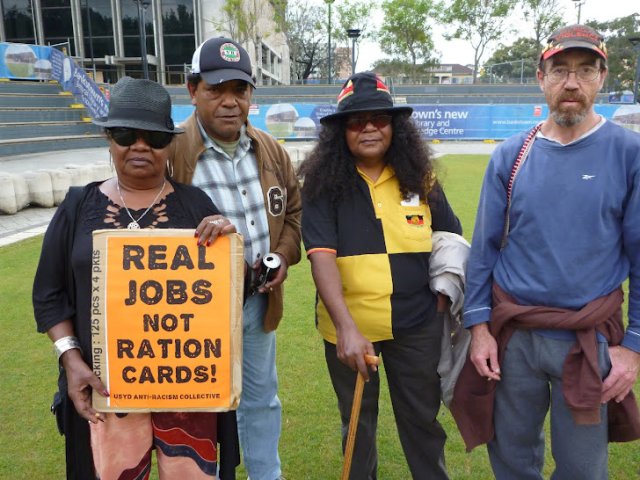
Compulsory income management must be opposed: this was the consensus from a lively August 29 community meeting hosted by the Socialist Alliance in Playford, northern Adelaide, where income management is being “trialled” for some welfare recipients.
This meeting included activists, locals, and representatives from community and welfare groups. People placed on income management have 50% to 70% of their payments put on a “Basics Card”, which can be used can be used to buy government-approved “essential” items.
Presentations from Pas Forgione from the Socialist Alliance and Left Unity, and Mike Williss, a research officer with the Australian Education Union (AEU) South Australia, explored the controversial policy, which was first applied to Aboriginal welfare recipients under the Northern Territory intervention.
AEU SA previously co-hosted with Left Unity an information session on compulsory income management for unions. AEU SA is concerned that children of those affected will be teased at school, and that income management will further stress already-vulnerable families, increasing the likelihood of family breakdown — things that have big implications for school counsellors and teachers.
There are compelling reasons to consider the income management “trials” a step towards the policy being rolled out across Australia. The federal government has ignored academic research and its own reviews that say income management is ineffective and harmful.
In a January submission to the Senate Community Affairs committee, the Australian Council of Social Services (ACOSS) said the high costs and unclear goals of income management meant it carried “a high risk of function creep”. That is, income management could be expanded to deal with problems for which the policy was not intended.
The more income management becomes an established, regular policy, the easier it will be to justify the enormous costs of carrying it out. This raises the prospect that income management will become a default, knee-jerk response to all kinds of complex social problems.
For example, ACOSS noted that federal government officials and state housing authorities had discussed referring social housing tenants who were behind on their rent to Centrelink with a view to placing them on income management. But ACOSS said the existing Centrepay scheme — which allows welfare recipients to nominate regular deductions from their payments — could deal with the problem without the cost or the humiliation of compulsory income management.
Current legislation allows for compulsory income management to be extended to more welfare recipients in new locations.
Alarmingly, two further new areas have been touted for income management: the Aboriginal APY lands of north-western South Australia, and the Western Australian Shire of Ngaanyatjarraku.
Compulsory income management in the NT applies to those who receive Youth Allowance for more than six months or the Newstart unemployment allowance for more than 12 months. But so far, the five “trial” income management outside the NT only targets welfare recipients classified under the “vulnerable” or “child protection” categories.
By first imposing compulsory income management on people in these two relatively small groups, the federal government is less likely to attract public attention or condemnation.
These “trials” allow the government to portray income management opponents as indifferent towards the welfare of children suffering abuse or neglect.
This is rather cunning of the federal government. However, child protection income management has many of the same problems as the other versions of compulsory income management. These include the tremendous cost, lack of solid evidence suggesting the policy works, the humiliation recipients undergo, and the availability of more cost-effective, just, and less intrusive welfare options.
Another problem is that perfectly competent and responsible people will become subject to compulsory income management in the future because Centrelink defines “vulnerable recipients” in a broad and vague way.
Centrelink provides several criteria to judge if a welfare recipient is “vulnerable”. One condition is “financial hardship”.
The truth is that most welfare recipients experience financial hardship — not mainly because of excessive consumption of alcohol or cigarettes, gambling or poor financial management — but because of extremely low payments they receive.
ACOSS says income management on the grounds of financial hardship is a kind of “double jeopardy”, which punishes recipients twice. That is, recipients are first forced to survive on an extremely low income and then are deemed to suffer from “financial hardship”, and so have half their payments quarantined on the Basics Card.
The federal government also uses voluntary income management to shield itself from criticism and scrutiny of the more controversial compulsory income management scheme. Most recipients in the “trial” sites will be on voluntary rather than compulsory programs.
But the expensive voluntary scheme’s aims can be achieved through the far more cost-effective Centrepay, which allows welfare recipients far more autonomy and flexibility. Centrepay has operated since 1999 and 500,000 people take part.
Centrepay allows recipients to choose how much of their payments will be withheld, rather than being locked into the 50% income management rate. Centrepay recipients are not locked into minimum 13-week periods, as is the case with income management.
If the federal government wants an effective tool to assist welfare recipients with their finances, it should put more resources into promoting Centrepay.
That the government’s income management “trials” includes voluntary income management does not make the policy any less objectionable.
Rather, compulsory income management in the NT shows that its extension is highly likely elsewhere in Australia. With so many more cost-effective and less stigmatising alternatives available, any income management scheme is an intolerable addition to our increasingly punitive welfare system.
Comments
Anonymous replied on Permalink